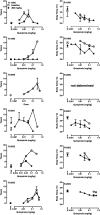Effects of chronic cocaine and ethanol self-administration on brain dopamine receptors in a rhesus monkey model of polysubstance abuse
- PMID: 36001440
- PMCID: PMC9413385
- DOI: 10.1111/adb.13219
Effects of chronic cocaine and ethanol self-administration on brain dopamine receptors in a rhesus monkey model of polysubstance abuse
Abstract
Most individuals with cocaine use disorder also use alcohol; however, little is known about the behavioural and pharmacological mechanisms that promote co-abuse. For example, although studies in humans and animals have documented that chronic use of either alcohol or cocaine alone decreases D2-like receptor (D2R) availability, effects of co-abuse of these substances on dopamine receptor function have not been characterized. These studies examined the effects of long-term cocaine self-administration in 12 male rhesus monkeys who also consumed either ethanol or an ethanol-free solution each day (n = 6 per group). Specifically, all monkeys self-administered cocaine (0.1 mg/kg per injection) 5 days per week in the morning. In the afternoon, six monkeys consumed 2.0 g/kg ethanol over 1 h to model binge drinking and six monkeys drank an ethanol-free solution. Assessment of D2R availability using positron emission tomography (PET) and [11 C]raclopride occurred when monkeys were drug-naïve and again when monkeys had self-administered approximately 400-mg/kg cocaine. D3 R function was assessed at the same time points by determining the potency of the D3 R-preferring agonist quinpirole to elicit yawns. Chronic cocaine self-administration decreased D2R availability in subregions of the basal ganglia in control monkeys, but not those that also drank ethanol. In contrast, D3 R sensitivity increased significantly after chronic cocaine self-administration in ethanol-drinking monkeys but not controls. These results suggest that co-use of ethanol substantially changes the effects of chronic cocaine self-administration on dopamine receptors, specifically implicating D3 R as a target for medications in these individuals.
Keywords: alcohol; drug self-administration; nonhuman primates; polysubstance abuse.
© 2022 The Authors. Addiction Biology published by John Wiley & Sons Ltd on behalf of Society for the Study of Addiction.
Conflict of interest statement
There are no conflicts of interests to disclose.
Figures



Similar articles
-
Association of dopamine D2-like and D3 receptor function with initial sensitivity to cocaine reinforcement in male rhesus monkeys.Brain Res. 2023 May 15;1807:148323. doi: 10.1016/j.brainres.2023.148323. Epub 2023 Mar 11. Brain Res. 2023. PMID: 36914041 Free PMC article.
-
Effects of chronic binge-like ethanol consumption on cocaine self-administration in rhesus monkeys.Drug Alcohol Depend. 2015 Aug 1;153:278-85. doi: 10.1016/j.drugalcdep.2015.05.016. Epub 2015 May 21. Drug Alcohol Depend. 2015. PMID: 26048636 Free PMC article.
-
Yawning elicited by intravenous ethanol in rhesus monkeys with experience self-administering cocaine and ethanol: Involvement of dopamine D3 receptors.Alcohol. 2018 Jun;69:1-5. doi: 10.1016/j.alcohol.2017.10.003. Epub 2017 Oct 17. Alcohol. 2018. PMID: 29550583 Free PMC article.
-
PET imaging of dopamine D2 receptors in monkey models of cocaine abuse: genetic predisposition versus environmental modulation.Am J Psychiatry. 2005 Aug;162(8):1473-82. doi: 10.1176/appi.ajp.162.8.1473. Am J Psychiatry. 2005. PMID: 16055768 Review.
-
Review. Positron emission tomography imaging studies of dopamine receptors in primate models of addiction.Philos Trans R Soc Lond B Biol Sci. 2008 Oct 12;363(1507):3223-32. doi: 10.1098/rstb.2008.0092. Philos Trans R Soc Lond B Biol Sci. 2008. PMID: 18640923 Free PMC article. Review.
Cited by
-
Association of dopamine D2-like and D3 receptor function with initial sensitivity to cocaine reinforcement in male rhesus monkeys.Brain Res. 2023 May 15;1807:148323. doi: 10.1016/j.brainres.2023.148323. Epub 2023 Mar 11. Brain Res. 2023. PMID: 36914041 Free PMC article.
-
Repeated Cocaine Intake Differentially Impacts Striatal D2/3 Receptor Availability, Psychostimulant-Induced Dopamine Release, and Trait Behavioral Markers of Drug Abuse.Int J Mol Sci. 2023 Aug 26;24(17):13238. doi: 10.3390/ijms241713238. Int J Mol Sci. 2023. PMID: 37686044 Free PMC article.
-
PKD1-mediated phosphorylation at dopamine D2 receptor serine 365 site in dorsal striatum underlies cocaine-induced locomotor hyperactivity.IBRO Neurosci Rep. 2025 Jun 19;19:124-132. doi: 10.1016/j.ibneur.2025.06.013. eCollection 2025 Dec. IBRO Neurosci Rep. 2025. PMID: 40606639 Free PMC article.
-
Sequencing hour-level temporal patterns of polysubstance use among persons who use cocaine, alcohol, and cannabis: A back-translational approach.Drug Alcohol Depend. 2024 May 1;258:111272. doi: 10.1016/j.drugalcdep.2024.111272. Epub 2024 Mar 22. Drug Alcohol Depend. 2024. PMID: 38555662 Free PMC article.
-
Effects of self- and experimenter-administered cocaine on subsequent ethanol drinking in rhesus monkeys.Drug Alcohol Depend. 2024 Jul 1;260:111347. doi: 10.1016/j.drugalcdep.2024.111347. Epub 2024 May 25. Drug Alcohol Depend. 2024. PMID: 38833794 Free PMC article.

